Tag: the value of less
Letting Go of Treasures
I tell people that after my grandparents died they came to live with me. My grandmother passed away in September of 2011, and my grandfather a few months later. I had a special connection with each of them and “sad” doesn’t begin to describe how I felt when they were gone.
The grieving process was long.
Managing their affairs was complicated.
My father and aunt had already passed away and so my grandparents entrusted me to manage the “death responsibilities,” as I call them. “Managing an estate” sounds like something a New York banker does for his millionaire clients. Death responsibilities are not glamorous. They included combing through files to locate every utility to change into my name until the house could be sold. They included cancelling subscriptions to magazines and newsletters.
Death responsibilities included standing in the middle of a home full of vases, record albums, tables, chairs, and boxes of dolls and doilies and wall hangings. Taking inventory, stacking boxes for the Goodwill, and bagging up load after load of half-empty bottles of aspirin, bug spray and chipped flower pots to take to the dump.
It was overwhelming.
It was heartbreaking.
My grandparents moved many times throughout their lives. My grandma started on a farm in North Dakota and her adventurous spirit took her to Washington, Hawaii, California, and finally to Oregon, with a brief experiment in Arizona along the way. My grandfather, who is actually my step-grandfather, also lived in many different places during his military career and then was along for the ride with my grandmother.
Each time they moved they brought all their old stuff with them and acquired new things. Each new house seemed to have more cupboards, more closets, more garage space. They weren’t hoarders. Their homes didn’t have stacks of papers or piles of stuff strewn everywhere; their possession were neatly stored. They just had a lifetime worth of belongings stuffed into every available space.
They cherished their belongings for the memories, and also held onto things out of a desire not to waste. They both had grown up in circumstances that required thrift.
Their belongings weren’t especially valuable. They were just plentiful. I took an entire trunk worth of jewelry to be cataloged and appraised, and dutifully wrote down “$0” next to each item’s listing as the jeweler told me “Costume jewelry, no value” over and over. It is true that most of the baubles were not made of precious metals or stones. From an estate inventory point of view, they were not worth anything. But they meant something to my grandma. They were gifts or handed down from her mother or purchased with her hard earned money. And because of that, they are worth something to me, too.
The last piece of jewelry that she received was a gift from me. Knowing her love for big, opulent pieces, I picked out a Stella and Dot ring with a swollen cluster of faux pearls, and brought it with me on one of my visits to see her. She was happy.
For a while I wore my grandmother’s jewelry every day. I set about ten of her necklaces and rings in my own jewelry box. But there is too much of it, an overwhelming amount, and the rest of it is hidden deep in a closet. Someday I will go through it again and decide what I truly want to wear and keep. And the rest of it…the tattered bracelets and faux diamond rings…I guess they will go to the Goodwill.
My grandmother had distinct taste. I loved that about her. And now I have what may be the world’s only brass chandelier painted over in a color best described as a cross between a muted turquoise and powder blue. I also have the leopard print chairs that she bought for her lanai when she lived in Honolulu. I have a photo of my dad sitting on one of those chairs during an R&R break from Vietnam.
Knowing how much they valued their possessions made it difficult to get rid of them. My relatives took some objects – paintings, a chair, a lamp, the computer, photos. I took the most belongings, a small trailer’s worth.
My grandfather had a silhouette painting on his bookshelf. Inscribed on the back was “From Daniel to Nana on Mother’s Day, May 1939.” If he had kept this treasure for 75 years, how could I give it away now? I have mixed feelings. I don’t want to be the keeper of the family heirlooms. Yet I feel obligated to keep these things.
My preference is to have minimal stuff. I don’t like having a lot of decorations in my home. I can’t stand visual clutter. The words “knick-knack” and “trinket” bother me.
I wanted my grandparents with me. After they passed away, the closest thing to having them with me was to surround myself with their belongings. My living room now has more objects that belonged to my grandparents than anything I acquired on my own.
It has been three years since they died. I’ve begun to think it is time for my grandparents to move out. My minimalist tendencies are getting stronger along with the desire to reflect my own style instead of living in a shrine.
One piece of furniture that I inherited is my grandfather’s armoire. It has four shelves and a glass door that locks with a key. That is plenty of room for his silhouette painting, his baby shoes and framed photos. It’s big enough to hold their memories. I can unlock it when I want to visit the past. Maybe I can let the rest go.
The Value of Less
One of my favorite things about the time I spent in Boulder at the Jack Kerouac School was living in my simple student apartment.
From the moment I walked in the door, I loved it. Even though it was a small one bedroom apartment it felt spacious and airy because there was hardly anything in it. It took me thirty minutes to put away all the belongings I brought with me. Another thirty minutes to rearrange my bed and desk.
Without stuff, life is simpler.
I had one suitcase worth of clothes, my computer, notebooks and not much else. The apartment came with a sofa, table, chairs, bed, desk and a few pieces of cookware and utensils in the kitchen. No microwave. No extra stuff – just the basics to live day to day.
It didn’t take long to decide what to wear because there wasn’t a lot to choose from. Which of my three tank tops to wear with jeans? Or which of my four dresses to pull on? If I was going to school, I wore my sandels. If I was walking anywhere else, sneakers.
I got so much writing done sitting at the desk in my bedroom. The walls were blank, so all of the ideas came from my head. No visual stimulation to distract me.
Returning home after living so sparingly was a shock. I felt like my house was screaming at me. Everywhere I looked there was stuff.
I decided to get rid of half of everything I owned. Much of what I had didn’t make sense for my new life. They were artifacts of the old life that I left behind when I quit my job and went out on my own. I didn’t want the clothes that I used to wear to work hanging up in my closet. I didn’t want boxes of computer equipment clogging up my bookshelf. I wanted blank space.
It was a good goal, but getting rid of half of everything I owned turned out to be more ambitious than what I was prepared to part with. After carloads of donations dropped off at the Goodwill, I hadn’t given away a even quarter of what I owned, and there were things that I wasn’t ready to part with. I wasn’t ready to give away the furniture that I inherited after my grandparents passed away. I didn’t want to get rid of Christmas decorations, cheese knives or nail polish. Even though I rarely use those things, the last thing I intended was to get rid of something only to repurchase it when I wanted it later.
I changed my goal to creating an empty drawer or shelf in every room of the house. That was doable.
I love these pockets of blank space. Especially around my desk, where I work. The less stuff I have in my line of sight, the more ideas make it out of my head and onto my PC.
I still have more stuff than I need or want. But I have much more breathing room.

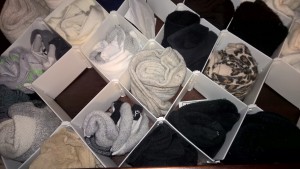 Or the title that I prefer: My sock drawer is good for business.
Or the title that I prefer: My sock drawer is good for business.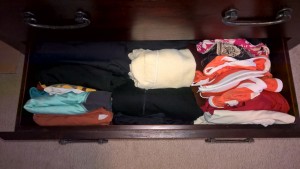

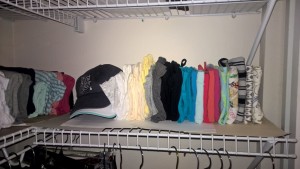
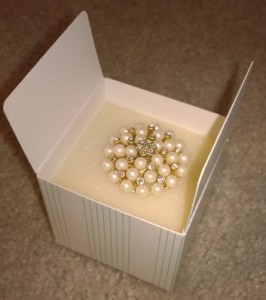
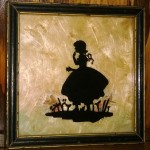

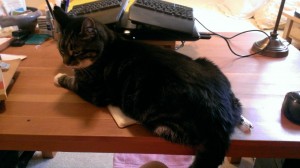
Recent Comments